Design and Analysis of Gallium Nitride-Based p-i-n Diode Structure for Betavoltaic Cell with Enhanced Output Power Density
Abstract
:1. Introduction
2. Device Structure and Simulation Method
3. Results and Discussion
4. Conclusions
Author Contributions
Funding
Conflicts of Interest
References
- Prelas, M.A.; Weaver, C.L.; Watermann, M.L.; Lukosi, E.D.; Schott, R.J.; Wisniewski, D.A. A review of nuclear batteries. Prog. Nucl. Energy 2014, 75, 117–148. [Google Scholar] [CrossRef]
- Spickler, J.W.; Rasor, N.S.; Kezdi, P.; Misra, S.N.; Robins, K.E.; Leboeuf, C. Totally self-contained intracardiac pacemaker. J. Electrocardiol. 1970, 3, 325–331. [Google Scholar] [CrossRef]
- Ko, W.H.; Hynecek, J. Implant evaluation of a nuclear power source-betacel battery. IEEE Trans. Biomed. Eng. 1974, 3, 238–241. [Google Scholar] [CrossRef] [PubMed]
- Rappaport, P. The Electron-Voltaic Effect in p-n Junctions Induced by Beta-Particle Bombardment. Phys. Rev. 1954, 93, 246–247. [Google Scholar] [CrossRef]
- Uhm, Y.R.; Choi, B.G.; Kim, J.B.; Jeong, D.-H.; Son, K.J. Study of a Betavoltaic Battery Using Electroplated Nickel-63 on Nickel Foil as a Power Source. Nucl. Eng. Technol. 2016, 48, 773–777. [Google Scholar] [CrossRef] [Green Version]
- Butera, S.; Lioliou, G.; Barnett, A.M. Temperature effects on gallium arsenide 63Ni betavoltaic cell. Appl. Radiat. Isot. 2017, 125, 42–47. [Google Scholar] [CrossRef]
- Chandrashekhar, M.V.S.; Thomas, C.I.; Li, H.; Spencer, M.G.; Lal, A. Demonstration of a 4H SiC betavoltaic cell. Appl. Phys. Lett. 2006, 88, 033506. [Google Scholar] [CrossRef]
- Thomas, C.; Portnoff, S.; Spencer, M.G. High efficiency 4H-SiC betavoltaic power sources using tritium radioisotopes. Appl. Phys. Lett. 2016, 108, 013505. [Google Scholar] [CrossRef]
- Simulation and Optimization Design of SiC-Based PN Betavoltaic Microbattery Using Tritium Source. Crystals 2020, 10, 105. [CrossRef] [Green Version]
- Munson, C.E.; Arif, M.; Streque, J.; Belahsene, S.; Martinez, A.; Ramdane, A.; Gmili, Y.E.; Salvestrini, J.-P.; Voss, P.L.; Ougazzaden, A. Model of Ni-63 battery with realistic PIN structure. J. Appl. Phys. 2015, 118, 105101. [Google Scholar] [CrossRef]
- Khan, M.R.; Smith, J.R.; Tompkins, R.P.; Kelley, S.; Litz, M.; Russo, J.; Leathersich, J.; Shahedipour-Sandvik, R.; Jones, K.A.; Iliadis, A. Design and characterization of GaN p-i-n diodes for betavoltaic devices. Solid-State Electron. 2017, 136, 24–29. [Google Scholar] [CrossRef]
- Munson, C.E.; Gaimard, Q.; Merghem, K.; Sundaram, S.; Rogers, D.J.; Sanoit, J.; Voss, P.L.; Ramdane, A.; Salvestrini, J.P.; Ougazzaden, A. Modeling, design, fabrication and experimentation of a GaN-based, 63Ni betavoltaic battery. J. Phys. D Appl. Phys. 2018, 51, 035101. [Google Scholar] [CrossRef] [Green Version]
- Lu, M.; Zhang, G.-G.; Fu, K.; Yu, G.-H.; Su, D.; Hu, J.-F. Gallium Nitride Schottky betavoltaic nuclear batteries. Energy Convers. Manag. 2011, 52, 1955–1958. [Google Scholar] [CrossRef]
- San, H.; Yao, S.; Wang, X.; Cheng, Z.; Chen, X. Design and simulation of GaN based Schottky betavoltaic nuclear micro-battery. Appl. Radiat. Isot. 2013, 80, 17–22. [Google Scholar] [CrossRef] [PubMed]
- McNamee, S.; Wagner, D.; Fiordaliso, E.M.; Novog, D.; LaPierre, R.R. GaP nanowire betavoltaic device. Nanotechnology 2019, 30, 075401. [Google Scholar] [CrossRef] [PubMed]
- Ionascut-Nedelcescu, A.; Carlone, C.; Houdayer, A.; von Bardeleben, H.J.; Cantin, J.-L.; Raymond, S. Radiation Hardness of Gallium Nitride. IEEE Trans. Nucl. Sci. 2002, 49, 2733–2738. [Google Scholar] [CrossRef]
- Polyakov, A.Y.; Pearton, S.J.; Frenzer, P.; Ren, F.; Liu, L.; Kim, J. Radiation effects in GaN materials and devices. J. Mater. Chem. C 2013, 1, 877–887. [Google Scholar] [CrossRef]
- Belahsene, S.; Saqri, N.A.A.; Jameel, D.; Mesli, A.; Martinez, A.; Sanoit, J.; Ougazzaden, A.; Salvestrini, J.P.; Ramdane, A.; Henini, M. Analysis of Deep Level Defects in GaN p-i-n Diodes after Beta Particle Irradiation. Electronics 2015, 4, 1090–1100. [Google Scholar] [CrossRef] [Green Version]
- Zheng, R.; Lu, J.; Liu, Y.; Li, X.; Xu, X.; He, R.; Tao, Z.; Gao, Y. Comparative study of GaN betavoltaic bettery based on p-n junction and Schottky barrier diode. Radiat. Phys. Chem. 2020, 168, 108595. [Google Scholar] [CrossRef]
- Bouzid, F.; Pezzimenti, F.; Dehimi, L. Modelling and performance analysis of a GaN-based n/p junction betavoltaic cell. Nucl. Instum. Methods Phys. Res. A 2020, 969, 164103. [Google Scholar] [CrossRef]
- Boguslawski, P.; Briggs, E.L.; Bernholc, J. Native defects in gallium nitride. Phys. Rev. B 1995, 51, 17255–17259. [Google Scholar] [CrossRef] [PubMed] [Green Version]
- Alugubelli, S.R.; Fu, H.; Fu, K.; Liu, H.; Zhao, Y.; Ponce, F.A. Dopant profiling in p-i-n GaN structures using secondary electrons. J. Appl. Phys. 2019, 126, 015704. [Google Scholar] [CrossRef]
- Cheng, Z.J.; San, H.S.; Feng, B.; Liu, B.; Chen, X.Y. High open-circuit voltage betavoltaic cell based on GaN pin homojunction. Electron. Lett. 2011, 47, 720–722. [Google Scholar] [CrossRef]
- Aydin, S.; Kam, E. Investigation of nickel-63 radioisotope-powered GaN betavoltaic nuclear battery. Int. J. Energy Res. 2019, 43, 8725–8738. [Google Scholar] [CrossRef]
- Zuo, G.; Zhou, J.; Ke, G. A Simple theoretical model for 63Ni betavoltaic battery. Appl. Radiat. Isot. 2013, 82, 119–125. [Google Scholar] [CrossRef]
- Belghachi, A.; Bozkurt, K.; Moughli, H.; Ozdemir, O.; Amiri, B.; Talhi, A. A Model for Ni-63 Source for Betavoltaic Application. Acta Phys. Pol. A 2020, 137, 324–331. [Google Scholar] [CrossRef]
- Wang, D.-F.; Shiwei, F.; Lu, C.; Motayed, A.; Jah, M.; Mohammad, S.N.; Jones, K.A.; Salamanca-Riba, L. Low-resistance Ti/Al/Ti/Au multilayer ohmic contact to n-GaN. J. Appl. Phys. 2001, 89, 6214–6217. [Google Scholar] [CrossRef]
- Ho, J.-K.; Jong, C.-S.; Chiu, C.C.; Huang, C.-N.; Chen, C.-Y.; Shih, K.-K. Low-resistance ohmic contacts to p-type GaN. Appl. Phys. Lett. 1999, 74, 1275–1277. [Google Scholar] [CrossRef] [Green Version]
- Atlas User’s Manual; Silvaco International Inc.: Santa Clara, CA, USA, 2016.
- Robertson, C.A.; Qwah, K.S.; Wu, Y.-R.; Speak, J.S. Modeling dislocation-related leakage currents in GaN p-n diodes. J. Appl. Phys. 2019, 126, 245705. [Google Scholar] [CrossRef]
- Cho, H.K.; Kim, C.S.; Hong, C.-H. Electron capture behaviors of deep level traps in unintentionally doped and intentionally doped n-type GaN. J. Appl. Phys. 2003, 94, 1485–1489. [Google Scholar] [CrossRef]
- Polyakov, A.Y.; Lee, I.-H.; Smirnov, N.B.; Govorkov, A.V.; Kozhukhova, E.A.; Pearton, S.J. Comparison of hole traps in n-GaN grown by hydride vapor phase epitaxy, metal organic chemical vapor deposition, and epitaxial lateral overgrowth. J. Appl. Phys. 2011, 109, 123701. [Google Scholar] [CrossRef]
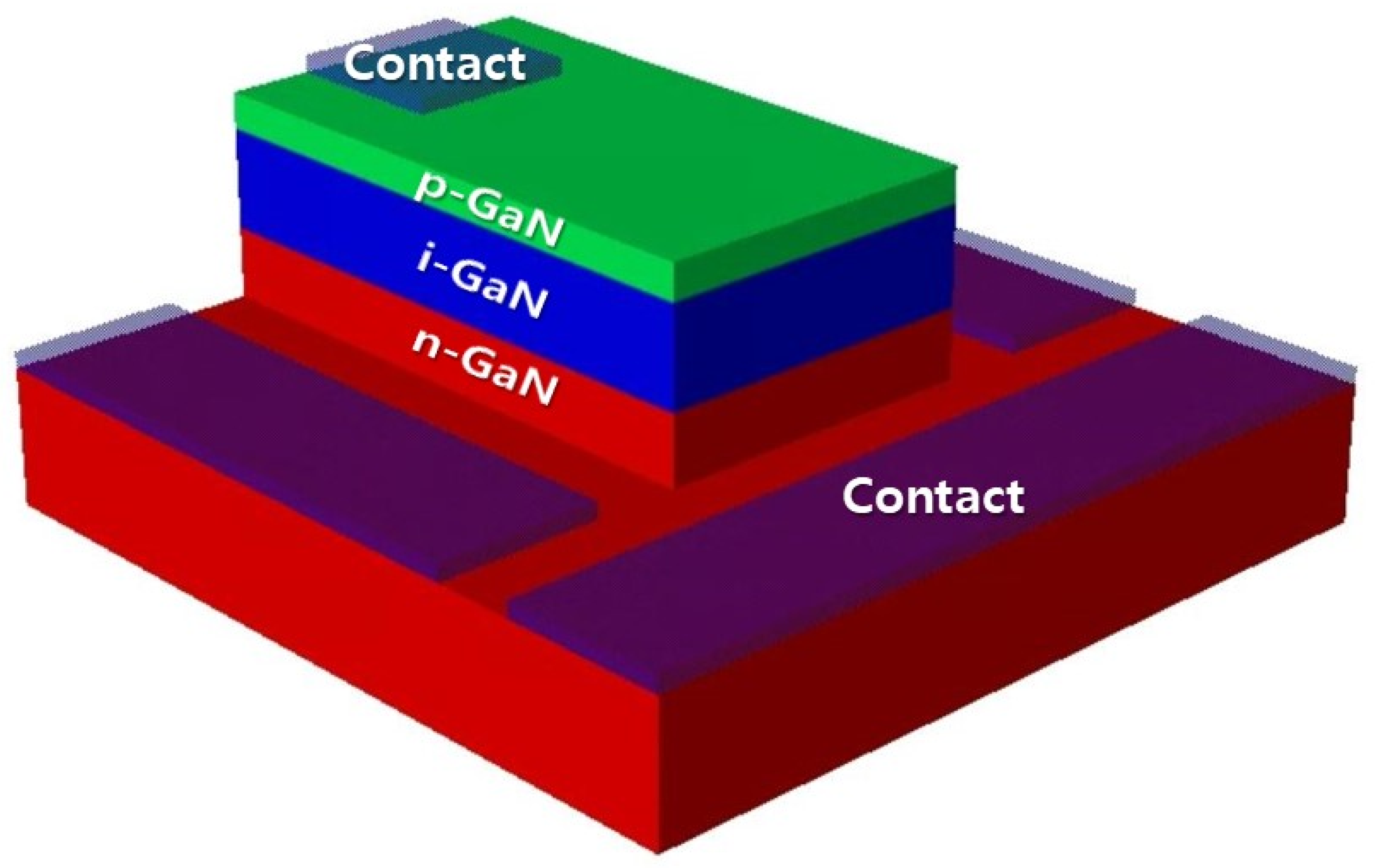
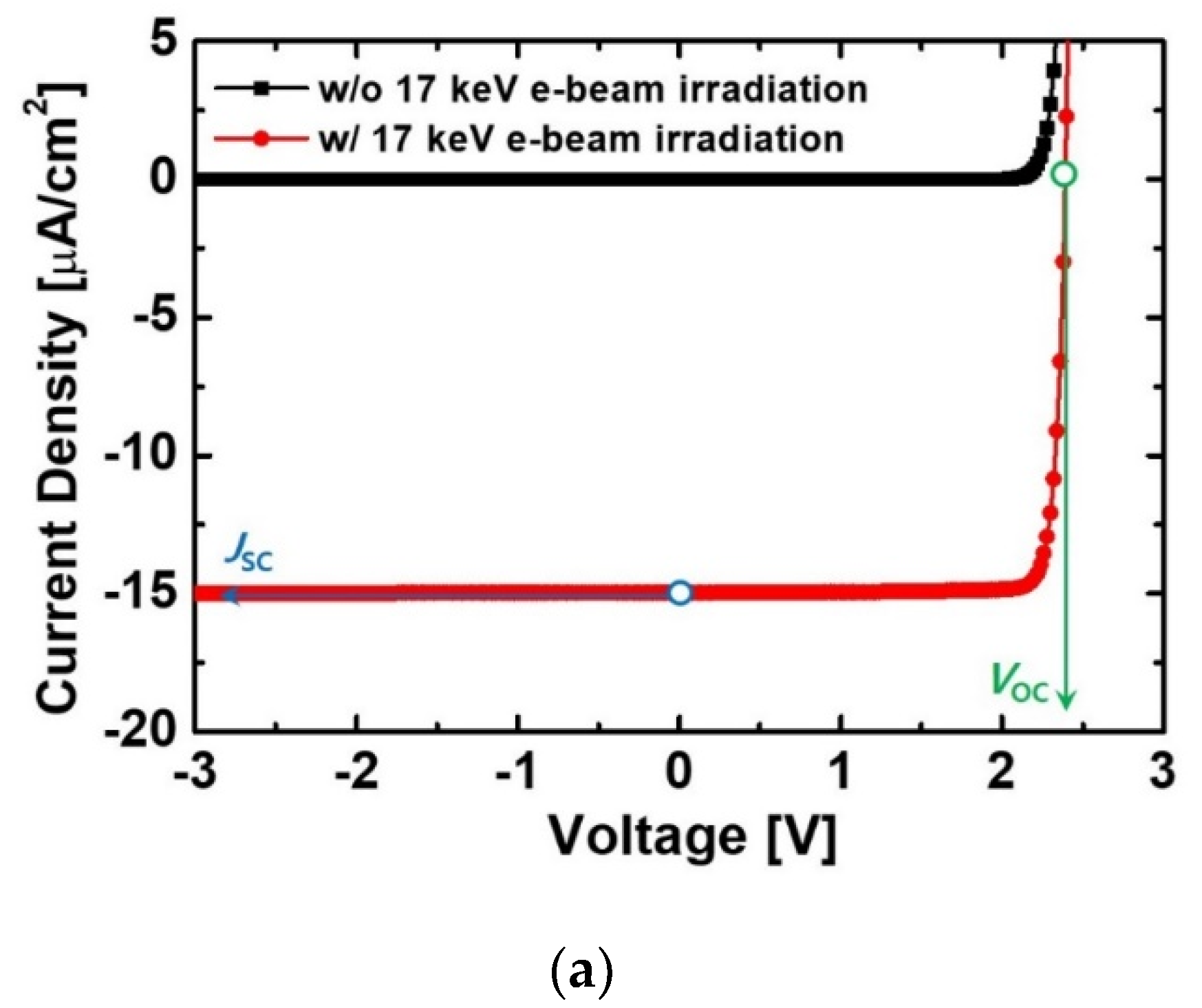
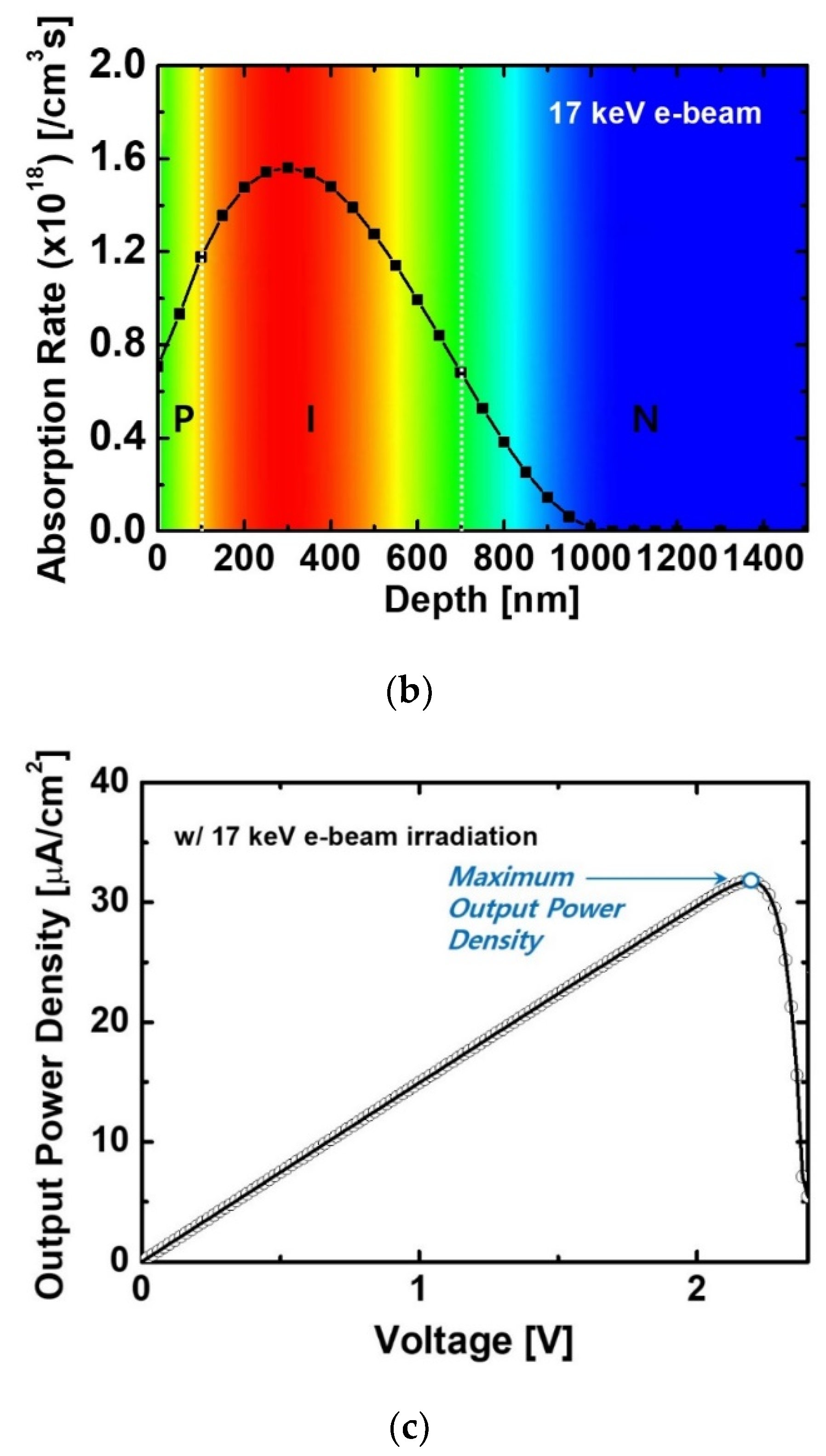
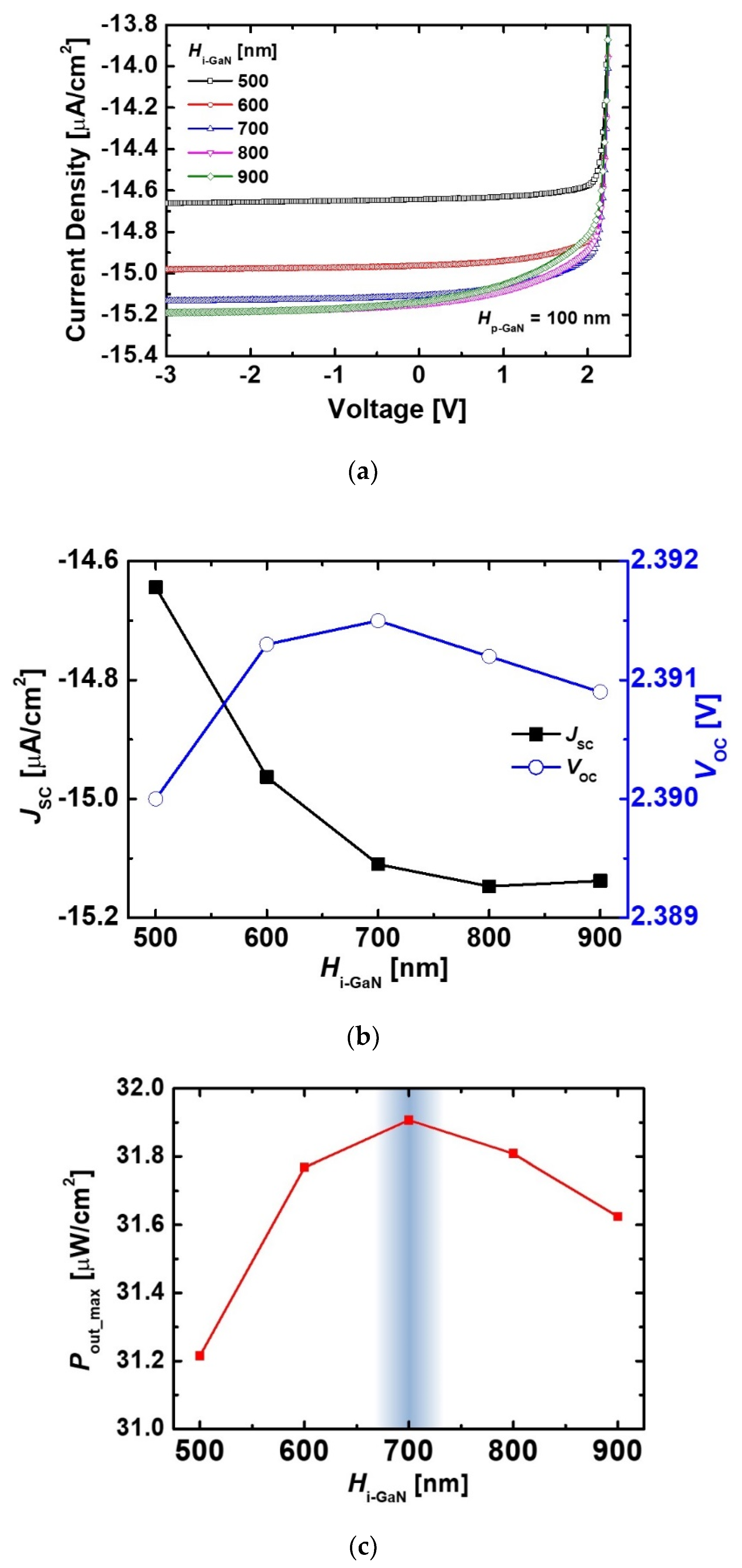


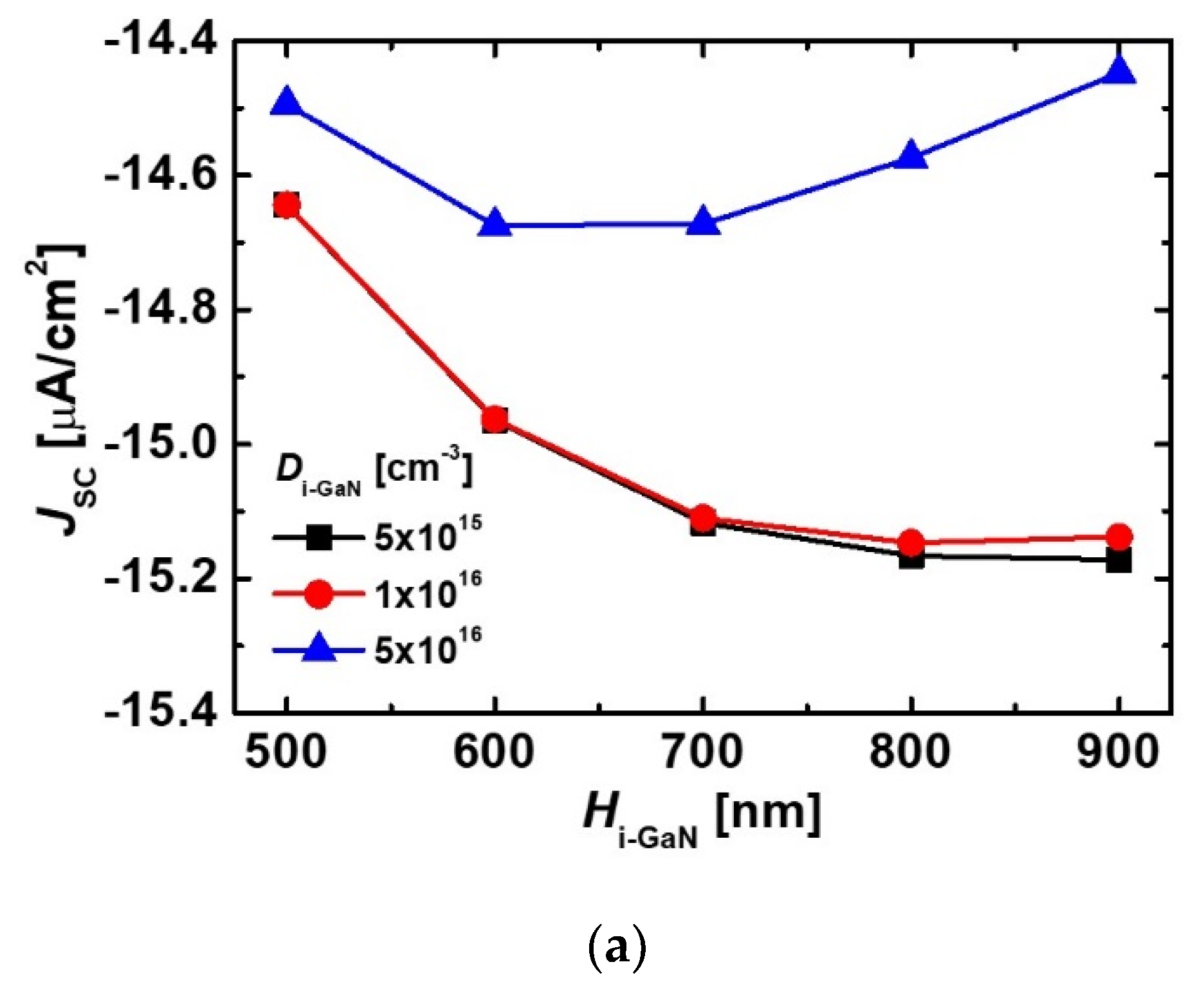
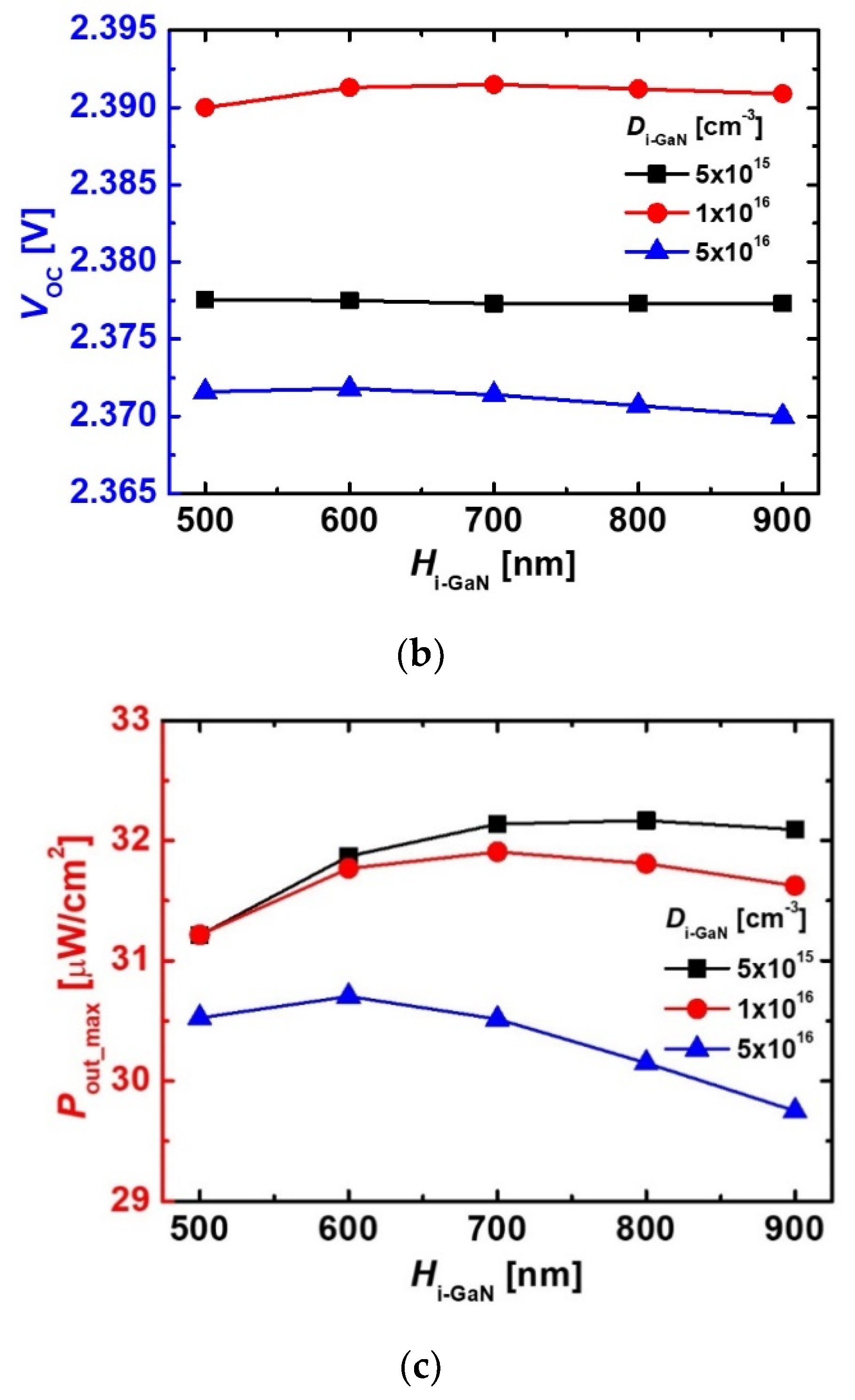


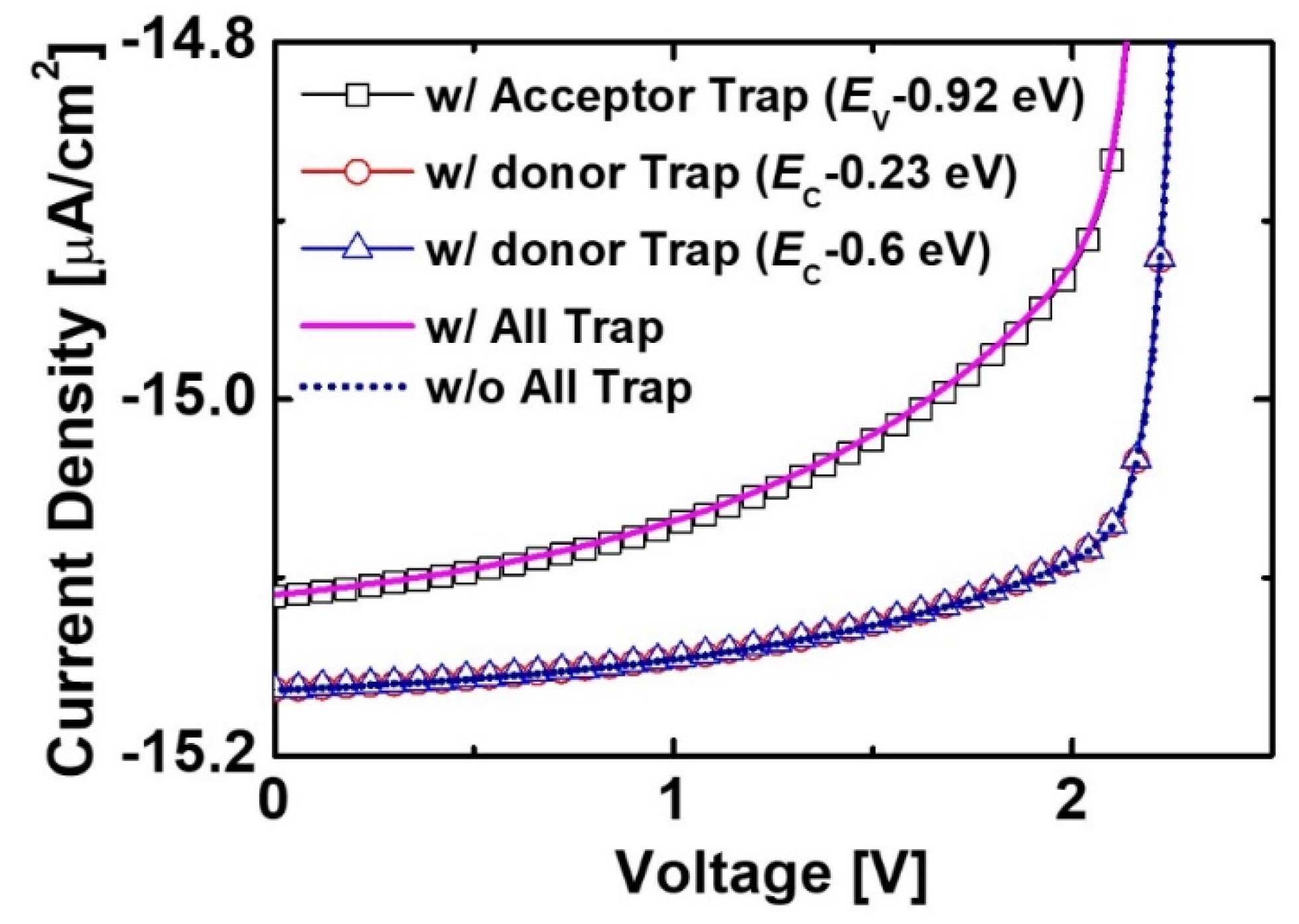

Publisher’s Note: MDPI stays neutral with regard to jurisdictional claims in published maps and institutional affiliations. |
© 2020 by the authors. Licensee MDPI, Basel, Switzerland. This article is an open access article distributed under the terms and conditions of the Creative Commons Attribution (CC BY) license (http://creativecommons.org/licenses/by/4.0/).
Share and Cite
Yoon, Y.J.; Lee, J.S.; Kang, I.M.; Lee, J.H.; Kim, D.S. Design and Analysis of Gallium Nitride-Based p-i-n Diode Structure for Betavoltaic Cell with Enhanced Output Power Density. Micromachines 2020, 11, 1100. https://doi.org/10.3390/mi11121100
Yoon YJ, Lee JS, Kang IM, Lee JH, Kim DS. Design and Analysis of Gallium Nitride-Based p-i-n Diode Structure for Betavoltaic Cell with Enhanced Output Power Density. Micromachines. 2020; 11(12):1100. https://doi.org/10.3390/mi11121100
Chicago/Turabian StyleYoon, Young Jun, Jae Sang Lee, In Man Kang, Jung Hee Lee, and Dong Seok Kim. 2020. "Design and Analysis of Gallium Nitride-Based p-i-n Diode Structure for Betavoltaic Cell with Enhanced Output Power Density" Micromachines 11, no. 12: 1100. https://doi.org/10.3390/mi11121100
APA StyleYoon, Y. J., Lee, J. S., Kang, I. M., Lee, J. H., & Kim, D. S. (2020). Design and Analysis of Gallium Nitride-Based p-i-n Diode Structure for Betavoltaic Cell with Enhanced Output Power Density. Micromachines, 11(12), 1100. https://doi.org/10.3390/mi11121100




